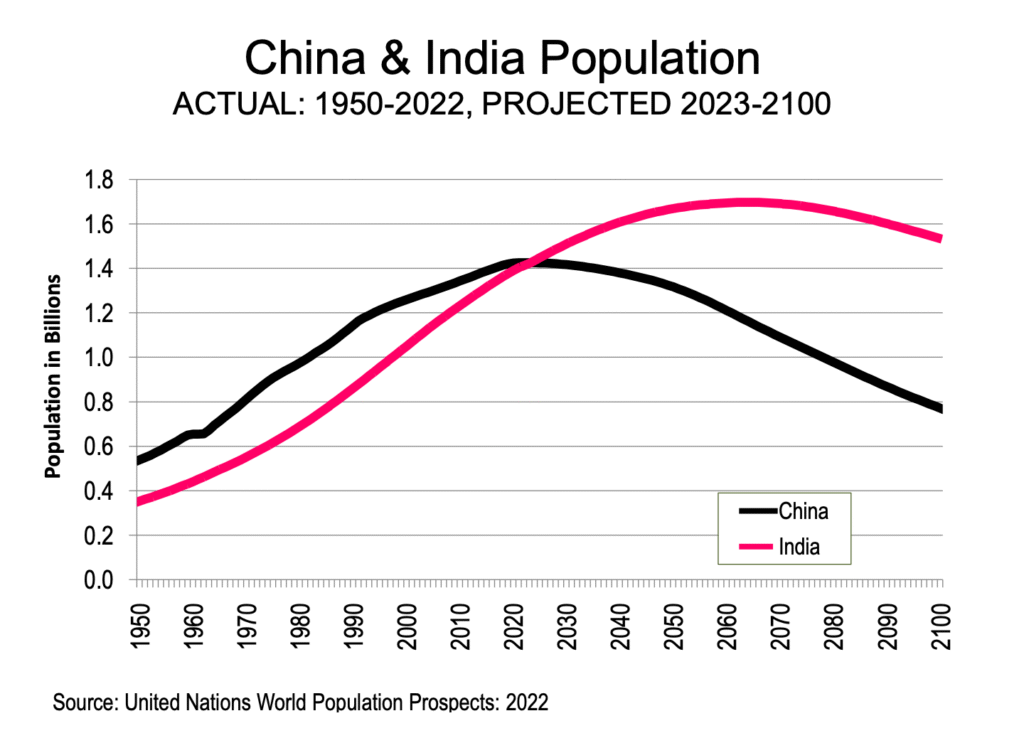
Photo Credit: New Geography
Sapna Suresh and Orwell Jin
The America-Eurasia Center
www.EurasiaCenter.org
Eurasia Brief
East Asia and South Asia Programs
America-Eurasia Business Coalition
www.usebc.org
Factors for China’s Decline
As many predicted, India is expected to overtake China’s population and according to a recent UN estimate, India is set to surpass China by April this year.1 By contrast, China’s population dropped for the first timesince for the first time since the Great Chinese Famine in the 1960s, according to the PRC’s National Bureau of Statistics.2
A key reason is economic, as the Chinese economy is beginning to slow down for several reasons, notwithstanding the increasing government restrictions on the technology and real estate industries. A key factor for the economic decline is the impact of the pandemic. In the last three months, China’s “GDP shrunk by 2.6% in the three months ending in June, while youth unemployment hit a record high of nearly 20%.”3 Aside from the pandemic, the trade war and broader tensions between Beijing and Washington have only exacerbated the situation. Nevertheless, many economists argue that China’s economy will rebound once the worse impacts of the pandemic end.
Importantly, similar to the US and other industrial countries in Western Europe, as the younger generation becomes more educated, they postpone marriage and creating families in favor of growing careers. A major focus now, it the increasing greying of China’s population, the 0.02% decline in population also adds to the growing proportionality of its aging society, following its neighbors in East Asia, namely Japan, and South Korea. As China’s GDP growth rates slow and the country turns into an aging society, a major focus will be whether China will fall into the middle-class debt-income trap which deserves further attention. A key factor to observe is China’s current liberalization of birth restrictions which have not stopped population decline. The Chinese government should put more incentives for childbearing by responding more positively to some key social issues – such as the high real-estate and educational costs as well as the controversy over the status of women in both family and workplace.
India’s Population
As the India’s population keeps growing, Chinese demographic dividend will decline. Now that Covid
restrictions are being lifted and US-China rivalry forces multinational corporations starts to relocate its
supply chains, many will be moving them from China to Southeast Asia and South Asia. One of the biggest
potential competitors to China is India. On January 31, 2023, the Biden Administration hosted meetings with
a delegation of Indian officials and U.S. industry executives, seeking to facilitate technology development and
investment in India as part of a broader U.S. push to cultivate alternatives to China.4 In addition, since about
27% of Indians are below the age of 25, this generation of Indians will be the largest market for consumer
goods and possess a wide-ranging knowledge base. Politically, having the largest population could bolster
New Delhi’s justification to have a permanent seat at the UN Security Council, something it has been pushing
for decades.5
However, at the same time, India’s growth rate does not reflect a population boom. “Rising incomes and
improved access to health and education have helped Indian women have fewer children than before,
effectively flattening the growth curve.” Importantly, the bulk of India’s population is in the northern parts
of the country, whereas in southern India, the decline in births have been faster. In addition, India’s growing
population is outpacing the rate of jobs available in the market. Six years ago, India’s labor participation was
46%, however now it has declined to roughly 40%. According to the estimates by CMIE (Centre for
Monitoring Indian Economy) the “female labor force participation fell to 9% by 2022 — putting India in the
same league as war-torn Yemen.”vi “Lack of high-quality education is one of the biggest reasons behind
India’s unemployment crisis” as “Indian institutions emphasize “rote-learning” over ‘creative
thinking.”6
Notably, like China, India suffers from a massive gender imbalance population, as there are more men than women, due to the cultural preferences to have a male son. In India, by 2030, there are estimated to be 6.8
million fewer girls born. Both New Delhi and Beijing have recognized the risks associated with this gender
imbalance ratio. In India, “the government, voluntary organizations, the media and some Bollywood stars
have all tried to alter these attitudes, and in some states government officials visit the homes where baby girls have been born to make a point of celebrating their arrival.7 In China, the government has offered financial incentives for families to have more children and has attempted to reduce the amount of abortions. However, many are critical of these moves as just another tactic for controlling the population.8
Further Reading
- Laura Silver, Christine Huang, and Laura Clancy, “Key Facts as India Surpasses China as the World’s Most Populous County,” Pew Research Center, February 9, 2023, https://www.pewresearch.org/short-reads/2023/02/09/key-facts-as-india-surpasses-china-as-the-worlds-most-populous-country/
- Evelyn Chang, “China’s Population Drops for the First Time in Decades,” CNBC, January 16, 2023, CNBC, https://www.cnbc.com/2023/01/17/chinas-population-drops-for-the-first-time-in-decades.html
- Necter Gan, “Zero-Covid was Supposed to Prove China’s Supremacy. How did it all go so Wrong for Xi Jinping?” CNN, December 28, 2022, https://www.cnn.com/2022/12/27/china/china-2022-zero-covid-intl-hnk-mic
- Vivian Salama, “U.S. Pursues India as a Supply-Chain Alternative to China,” Wall Street Journal, January 31, 2023, https://www.wsj.com/articles/u-s-pursues-india-as-a-supply-chain-alternative-to-china-11675201893?
- Soutik Biswas, “India v. China: Is Becoming the Most Populous Country a Boon or Curse,” BBC, December 20, 2022, https://www.bbc.com/news/world-asia-india-63957562
- Vrishti Beniwal, “Why India’s World-Beating Growth Isn’t Creating Jobs,” Bloomberg, November 30, 2022, https://www.bloomberg.com/news/articles/2022-07-15/why-india-s-world-beating-growth-isn-t-creating-jobs-quicktake
- Diksha Madhok, “India is set to Become the World’s Most Populous Country. Can it Create Enough Jobs?” CNN, January 17, 2023, business/india-population-worlds-largest-hnk-intl
- Amrit Dhillon, “Selective Abortion in India Could Lead to 6.8m Fewer Girls Being Born by 2030,” The Guardian, August 21, 2020, https://www.theguardian.com/global-development/2020/aug/21/selective-abortion-in-india-could-lead-to-68m-fewer-girls-being-born-by-2030
- Jessie Yeung and Nectar Gan, “China says it is Restricting Abortions to Promote Gender Equality. Experts are Skeptical.” CNN, October 1, 2021, https://www.cnn.com/2021/10/01/china/non-medical-abortions-mic-intl-hnk





